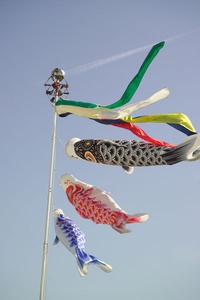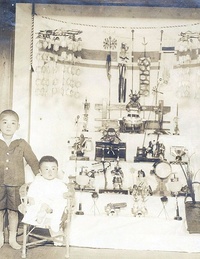In 1948, during the McArthur shogunate and Tatsu Katayama’s premiership, the Japanese government determined to officially declare May 5th as Kodomo no Hi, or Children’s Day. The government’s intention was to celebrate a special day for children, and to honor their parents. However, since the way to hell is always paved with good political intentions, that decision triggered a big racket from boys, girls, and their parents. Accustomed to celebrating May 5th exclusively as their day, boys felt cheated out. In turn, the demoiselles were indignant and wondered, “How come March 3rd wasn’t also declared an official holiday?” Be as it may, Boys’ Day bit the dust and instead officially became the unisex Children’s Day.
Wherever you go in Japan around the start of April, you may find rows and rows of long bamboo poles adorned with colorful koinobori, cloth or paper carps, some several feet long. But if you are lucky enough to be in a small Tohoku mura1, watching the koinobori array, the experience will be forever haunting. Blown by the breeze, the giant carps float lazily in the air, their colors flecking the majestic background of Mount Zao. If the wind abates, the fish will rest against the pole, much like the giant catch of an ancient god returning from a monstrous fishing expedition. The sight will forever twirl in your memory reminding you of how awesomely beautiful your Japan really is. You might want to know that Kazo, a small city of about 70,000 people in the Saitama Prefecture, produces most of the carps for Boys’ Day.
Perhaps less ambitious is the display of carp, remembering the day, in most of our Nisei organizations in town.
The largest carp, usually black, symbolizes Papa. A smaller red one flies for oniisan, or elder brother. Then, still smaller, blue, purple or white fish swim for ototo and the rest of the ko-tachi, or the youngest boys. Above the fish flies a small circular streamer, called the fuki nagashi, showing the Buddhist red, yellow, green, white, and blue mystical colors. The pole may be also adorned with a complex whirligig; or crowned with a bough of sakaki2 leaves set inside the top end. Nearby, you might also see one or more e-nobori, long banners with pictures, calligraphy or lucky symbols. With so many elaborate trappings, one wonders how, why and when Boys’ Day became so important in the Japanese culture.
As with Hina matsuri, in tracing its development you come across some delightful jolts. My first shock was to learn that the festival has been known as: Sechie, an original Chinese humdinger; Dragon Boat Day; Jugo no hi, or double-five day; Ayame no sekku and Shobu matsuri, Iris Festival; and ultimately as Tango No Sekku, or Zodiac Horse and Edge Day. Learning that the original celebration had nothing to do with boys makes you also shudder. It was a day to scare away the spirits of crop failure, hunger, poverty, sickness, and misfortune, and to attract those of fertility and abundance; a day to propitiate the gods, put all the community’s evils into a reed boat, and send them into celestial space. This is ideal for our current problems, neh?
But, here is something to make feminists belch fire. Tambo, the rice paddy, its muddy water, and ayame, the iris, are mystically connected. The iris’ flowers are sweet smelling and loaded with magical, cleansing and healing powers. The plant always remains beautiful, clean and upright, even when growing at the edge of the sludge. In fact, it absorbs the water’s spirit from that mucky environment. Iris leaves resemble swords at the ready, and they are symbolic of spiritual and sexual energy, and of eternal vigilance against evil.
In the old days the main workers in the tambo were the young women known as saotome; and they were considered unclean. Ready for the denouement? The primary purpose of the ayame no sekku festival was to cleanse the burden of impurity from the young tambo workers.3 In fact, iris leaves were inserted under the eaves of their homes for the cleansing. (I can’t ever imagine how, after a back-breaking day in the paddy—hot, sweaty, and with the mud up to their knees—the saotome were expected to remain pristine, immaculate, gorgeous, and ready to jump into the Playboy centerfold.)
One more bit of trivia, please. Shortly after the Padres were able to worm themselves into Japan, they decided to “rescue” and “purify” the day from its “heathenish origins.” So they superimposed on the festivity a new patron, Saint John the Baptist, a spirit quite familiar with water in other distant lands.4 So much for acculturation.
Japanese feudalism managed to find less reverent interpretations for the fifth day of the fifth month. So around 747 AD, Emperor Shomu threw a special shindig of archery and horsemanship in his palace grounds. He adorned his head with a wig of iris leaves, and ordered everyone approaching his place to carry some of the plant’s leaves. From then on, the court celebrated yearly competitions and displays of martial arts on that day. Some time in the eleventh century, the Court chose to engage in less virile bouts. Courtiers competed for honors based on who could grow the longest and strongest iris roots and compose the best poems about it.
However, the commoners went for mock battles with wooden swords, slinging stones, and toy bows and arrows. Of course, occasionally mock battles produced real casualties, and when occasionally became frequently, the shogunate declared such “games” unlawful. Instead it allowed shobu uchi, mock battles with swords of iris leaves with which one beat the ground, not an opponent, to drive away pesky demons. Boys, being always boys, started using their iris leaves swords against each other, and co-opted the day for themselves. And, since on that day, too, parents started visiting the temples to pray for their progeny, the seed of Boys’ Day germinated.
It took about 400 years or so for the new cultural “species” to bloom into the formal, elaborate, and luxurious event precursor of the current festivities. By the 1700s, with the peace and relative comfort of the Tokugawa rule, people began displaying outside their homes, the old warrior’s paraphernalia in full array. When that became too cumbersome, parents chose to set smaller replicas on the tokonoma. Doll images of military heroes—real and mythical—joined the picture, or displays, but were less elaborate than those for the girls.
By now too, the celebrants began using the e-nobori, or hanging pictures, first illustrated with the family crest, and later with calligraphy or heroic figures. Soon, however, someone came up with the idea of the floating carps. The high-leaping fish is the symbol of resolve, masculinity, daring and triumph. Boys need be as full of grit as the legendary carp that, having surmounted the awesome falls of the Chinese Yellow River, keeps climbing to the skies and becomes a mighty dragon. Since koi also stands for love, the carp symbolizes the eternal love of the boy towards his parents.5
In the next chapter, read about Tango no Sekku closer to what it is today.
Notes:
1. Mura: a small hamlet or village
2. Sakaki: “Prospering tree.
3. Kitamura, Yoshishika, “DARUMA,” Autumn, 2001
4. Casal, U.A.: “The Five Sacred Festivals of Japan,” Tokyo, 1967. Sophia U. pps/61-78
5. Casal; ibid
*This article was first appeared in the East San Gabriel Valley’s Japanese Community Center’s “Newsette” in May 2008.
© 2008 Edward Moreno







